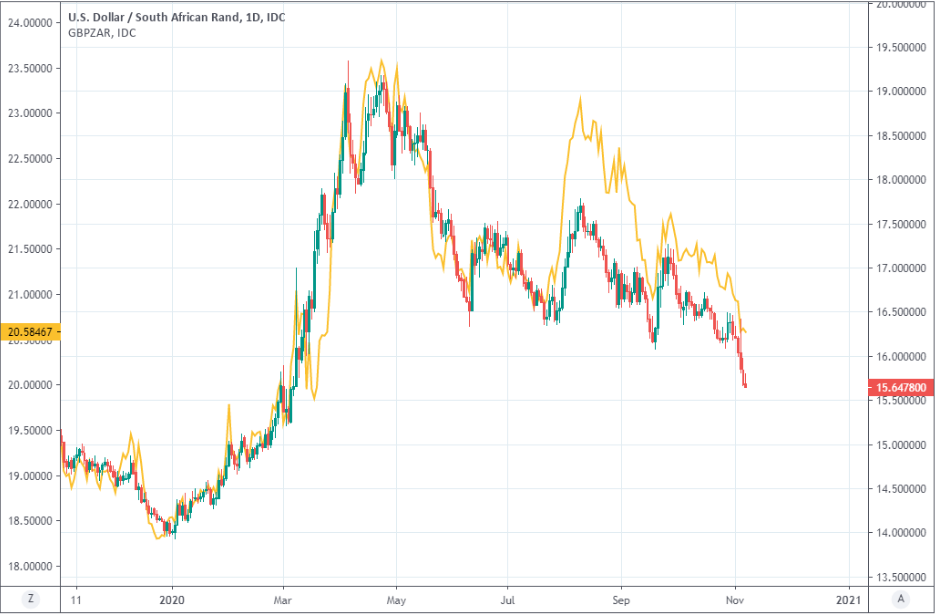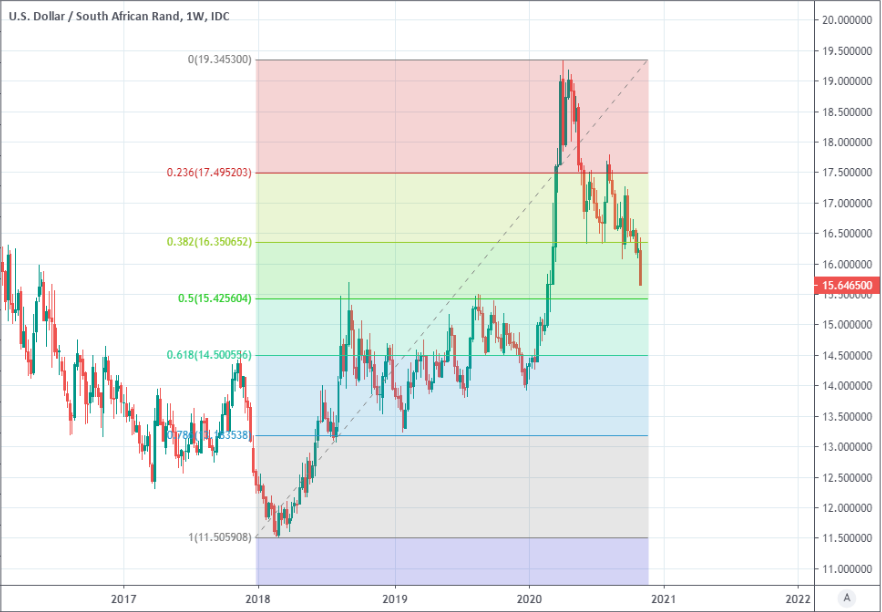South African Rand Reverses March Coronavirus Collapse as Charts Point Higher
- Written by: James Skinner
-

Image © Adobe Images
- GBP/ZAR spot rate at time of writing: 20.53
- Bank transfer rate (indicative guide): 19.82-19.96
- FX specialist providers (indicative guide): 20.13-0.35
- More information on FX specialist rates here
The Rand all but erased its coronavirus-inspired collapse against the Dollar Friday as market expectations for a changing of the guard in Washington solidified, although technical analysts and some traders have tipped the South African unit for even further gains ahead.
South Africa's Rand pushed up to its highest level against the Dollar since March 09 and the point when the coronavirus began to close down economies outside of China, as investors reacted to the solidifying prospect of a Democratic Party administration in Washington by selling the U.S. Dollar and stocks the world over.
It's not clear if moves seen in stock markets were merely profit-taking following strong gains earlier in the week, or the beginning of something more meaningful. Most major and emerging market currencies did, after all, continue their earlier advances against the U.S. Dollar for the session.
"We have seen decent inflows in ZAR from real money accounts while hedge fund clients mostly took profits on ZAR longs. I think the feeling is that not many people parcipated in the recent EM rally. Posioning across EMFX is sll light even aer the past few days of a very construcve price acon. There is room for more inflows in EMFX," says Yuliya Kryzhanovska, a trader at Credit Suisse. "The Rand should continue to benefit from USD lower momentum."
Bearish sentiment toward the Dollar continued to build as presidential challenger Joe Biden was said to surpass decisive milestones in certain U.S. swing states that are key to whether he emerges from Tuesday's election as America's candidate for the White House over the next four years.
Above: USD/ZAR shown at daily intervals alongside Pound-to-Rand rate (yellow line, left axis).
"The rand benefited from a significantly improved global risk sentiment following the presumed change in the White House. We have adjusted our forecasts accordingly, but we are skeptical that the upswing will be long-lasting. Due to domestic challenges, the ZAR remains vulnerable to global risks. We therefore continue to see only limited ZAR appreciation potential," says Elisabeth Andreae, an analyst at Commerzbank, who forecasts a USD/ZAR recovery back to 16.0 by year-end and a EUR/ZAR fall to 18.40, although the Pound-to-Rand rate is tipped for a recovery to 21.12.
Incumbent President Donald Trump and the Republican Party have for their part contested the results in a number of swing states and are seeking legal action, citing irregularities and alleging fraud, which risks leading to months of legal wrangling and acrimony if evidence of any malpractice can be produced.
Beyond the issue of whether the burden of evidence is ever satisfied, of most importance to the U.S. Dollar is the question of whether the Republican Party can hold onto its majority in the Senate, the answer to which may have to wait until after a recount in the state of Georgia has been carried out in January.
"The local currency is still rallying on the back of the US elections, where presidential candidate Joe Biden has a slight edge over the incumbent and possibly outgoing president Trump, while the rest of the emerging market currencies also had decent gains against the greenback. The rand rally feels somewhat overdone as it trades around 15.70 this morning," says Tebogo Mekgwe, a derivatives structurer at Rand Merchant Bank.
Above: USD/ZAR at weekly intervals with Fibonacci retracements indicating support levels for USD and resistance for ZAR.
Dollar losses and Rand gains had dragged USD/ZAR below an important support level at 15.69 ahead of the weekend, setting it on a course for lows not seen since February, according to some technical analysts.
"A daily close below nearby support at 15.6958 would extend the decline, targeting 15.4293 (50% retracement of the 2018-2020 bull market) and 15.2139 thereafter," says George Davis, chief technical strategist at RBC Capital Markets. "Valuation driven retracements to resistance at 16.0841 and 16.4968 are expected to attract selling interest."
A majority in both houses of Congress is necessary for the Democratic Party to implement the large spending programme it's advocated, which the market has viewed as likely to lead to increased Federal Reserve (Fed) Dollar creation through the quantitative easing programme under which it buys U.S. government bonds. This combined with a coveted reversal of 2018's Trumpian tax cuts, a penchant for heavier regulation of business and a clampdown on the fossil fuel sector in the name of containing climate change were all meant to help sink the Dollar for months more yet.
As a result, and rather than profit-taking, it could've been the residual chance of Democratic Party lawmakers taking control of the Senate that sunk stock markets and the Dollar while lifting the Rand on Friday, although it's impossible for any one person or entity to determine conclusively.
"There are a few reasons to remain cautious. The first is the fact that the threat of a contested vote in the US is still very real and next few days could be crucial in this respect. There is also some risk the Democrats could still take control of the Senate, although we will not know until potentially as late as January and the Georgia run-off elections. The rebuilding of a ‘blue-wave’ risk would temper equity markets," says David Forrester, a strategist at Credit Agricole CIB.












